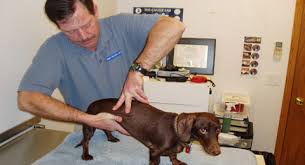 In recent years many holistic veterinarians have become trained in chiropractic methods and apply them therapeutically for many conditions, either as a primary or supportive treatment.
In recent years many holistic veterinarians have become trained in chiropractic methods and apply them therapeutically for many conditions, either as a primary or supportive treatment.
Many people think of chiropractic as a natural method for effective relief of back pain. Chiropractic offers much more-for humans as well as pets. It involves a system of locating spinal and joint misalignments throughout the body and adjusting them through a series of treatments that reduce the stressful impact on the nervous system and organs. Such misalignments pinch nerves and cause pain as well as disturbances to normal behavioral and physical functioning. Misalignments commonly occur from injury, birth trauma and wear and tear of the body. They can also result from malnutrition and toxicity, often present to some degree in chronic diseases. In many cases of prolonged illness, an undiagnosed misalignment may be present that is contributing to the problem.
Without chiropractic evaluation, misalignments may never be diagnosed and may produce a lifetime of suffering. The aim of chiropractic is to restore the normal structural alignment of the body so that energy flows better and moving parts work more optimally. Some chiropractic vets say they see immediate results after just one adjustment-dogs walking differently, stretching out, shaking and wagging their tails. Some chiropractic vets combine chiropractic with acupuncture. They use the acupuncture to relax the muscles before the adjustment.
How Chiropractic can help your dog
Chiropractic techniques most typically treat dogs for musculoskeletal problems stemming from hip dysplasia, arthritic changes and injury. Dogs hit by cars for instance, may suffer joint misalignments in addition to more obvious effects of trauma such as bone fractures or lacerations. Even the constant tugging on a leash can create a spine that may benefit from chiropractic treatment.
Chiropractic benefits older animals with joint stiffness and back problems, the result of a lifetime of minor trauma from jumping and running. Such minor injuries are not apparent at the time they occur, but they add up and may eventually slow an animal down over time.
Many dogs suffer from slight misalignments that are not identified by X-ray. Though subtle, they have the potential at any time in life to upset the normal biomechanics of motion and cause inflammation and degeneration of tissue. These situations are often resolved by gentle chiropractic adjustments. Lameness is an example. Either the hips or forelegs may be involved. Frequently the pet owner believes the cause is arthritis, yet the X-rays are negative. The problem may stem from a nerve impingement from a spinal or joint misalignment that develops pain or reduces nerve supply to a leg, similar to sciatica in humans.
Veterinarians are often able to relieve Beagle neck syndrome. With their heads continually on the ground during intense hunting activity, Beagles and other hunting animals stub their noses so many times that they frequently develop misalignments in the cervical spine (the neck).Many dogs with epileptic seizures who do not respond well to anticonvulsant drugs may have a misalignment in the first vertebrae in the neck. A misaligment there can exert an array of adverse effects on the nervous system, including seizures. Adjustments often improve the control of the condition and may even stop the seizures. This type of problem usually requires several treatments and regular maintenance because there is so much movement in the neck bones which heightens the potential for misaligment to occur.
How to tell if your dog can benefit from Chiropractic Treatment
Misalignment can occur at any time in a dog’s life and cause a variety of problems. Listed below is a checklist to help identify if your dog is affected.
The neck may be misaligned if the head is cocked to one side or another or if the dog is reluctant to raise it’s head or flex it’s neck without crying.
The jaw may be misaligned if a puppy becomes cranky and appears uncomfortable when nursing. If there is a sudden behavioral change after the dog has undergone a teeth cleaning, oral surgery or has been intubated. If there is a shaking of the head or scratching of the face or ears, especially on one side, this could be a sign of cranial misalignment.When seizures occur and medication doesn’t help, if the mouth is sore when you try to open it, if the dog is reluctant to chew it’s bisquits or if the dog has a distressed look or is acting depressed these can be signs of jaw misalignment or headaches.
The ribs or breastbone may be misaligned if the dog walks on it’s tiptoes, as if walking on high heels. This can be confirmed if you lift the animal with your hands under the chest and it cries out.
A spinal misalignment in the lower back may be involved if the dog walks like a camel, with it’s back humped or if he cries when he sits and acts as though he is sitting on a cactus.
The pelvis or hip may be out of line if the animal sits off to one side.
The Veterinarians Guide to Natural Remedies for Dogs
